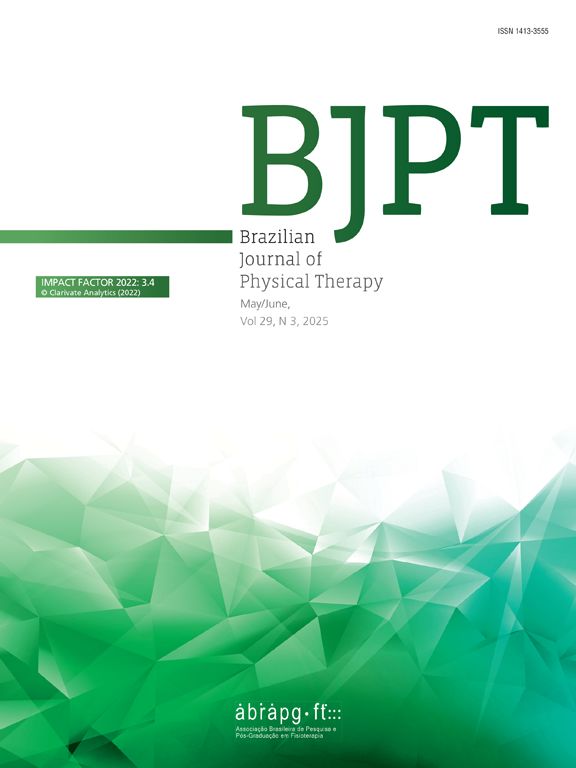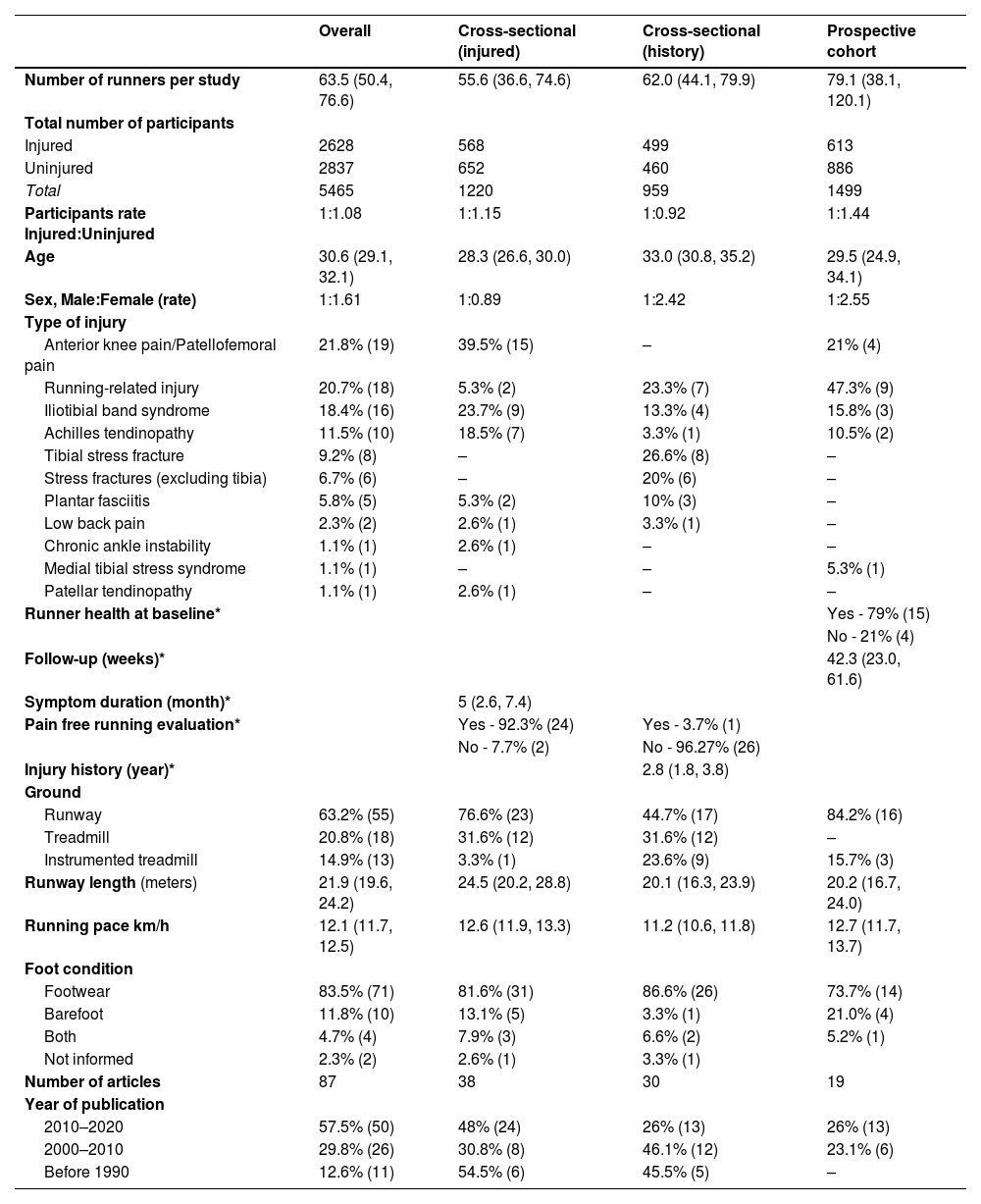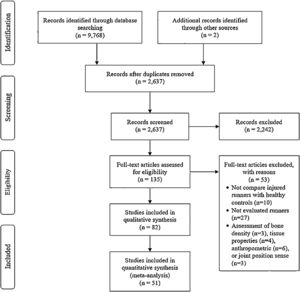No systematic review has investigated the main biomechanical variables as predictors of running-related injuries.
ObjectiveTo investigate the main biomechanical variables associated with running-related injuries.
MethodsMedline via PubMed, EMBASE, SPORTDiscus, Web of Science, and CINAHL were searched from inception until 1 November 2021. Each study included must have investigated the association of at least one biomechanical variable (kinetics, kinematics, electromyography, or pressure distribution) with running injuries. The meta-analysis was conducted, and a modified version of the Downs and Black Quality Index was used for methodological quality evaluation.
ResultsAcross the 82 studies included, 5465 runners were investigated. The meta-analysis was conducted with 11 biomechanical variables from 51 articles (n=2395). The peak hip adduction angle was the sole biomechanical variable associated with running injury and was found to be higher in injured runners (0.57, 95% CI 0.21, 0.94) compared to uninjured runners. However, this result was highly influenced by two studies (out of five studies) conducted by the same group of authors.
ConclusionClinicians, coaches, and runners should be aware that minimal evidence supports that alterations of running biomechanics are associated with running-related injuries. Heterogeneity in evaluation conditions and inconsistency in the naming and definitions of biomechanical variables make definitive conclusions challenging.
Systematic review registration numberPROSPERO, CRD42017068839
Running is one of the most popular physical activities around the world. It offers benefits including weight control and reduced risk of cardiovascular disease and other health problems.1,2 However, running results in a substantial risk of musculoskeletal injuries.3 Several studies have shown that the incidence of running injuries varies between 3.2% and 84.9%,4 or 2.5 to 33.0 injuries per 1000 h of running.5,6 Running injuries are believed to be related to the overloading of the musculoskeletal system caused by repeated microtrauma, typically without a single and identifiable event.3,7,8 This is due to the repetitive nature of the activity, with runners striking the ground approximately 1000 times per foot, per mile.
Injuries can result from several factors, including anatomical characteristics of the runners and training errors, such as training volume, weekly distance, and running experience.3,9-12 Running mechanics are also believed to play a significant role in the etiology of injuries. Over the last 30 years, numerous studies have examined the relationship between common running injuries and specific biomechanics, such as excessive foot pronation and excessive vertical ground reaction force loading rates.13-21 It has been suggested that: excessive peak hip adduction angle may result in abnormal loading in the tibia,22-24 excessive knee internal rotation may increase the torsional strain in the iliotibial band,25-27 and altered kinematics of the rearfoot may change the load distribution within the lower extremity, predisposing individuals to develop a running injury.24,28 However, it is challenging to find consistent evidence to support which biomechanical variables are related to specific running-related injuries.
Some reviews were published exploring the association between biomechanical variables and running-related injuries. However, these studies focused on a specific injury (e.g., runners with Achilles tendinopathy),29 or some specific biomechanical variables (e.g., vertical impact peak),30 or focused only on a specific study design (e.g., prospective cohort).31
Despite the great interest in the scientific and clinical communities, to our knowledge, no systematic review has performed a comprehensive review of the main biomechanical variables associated with running-related injuries. Synthesis of the literature using rigorous methods and a comprehensive and up-to-date search may help clinicians, researchers, and the running community to understand which biomechanical variables are essential to be considered or monitored during evaluation, treatment,training, and/or injury prevention programs. Therefore, this study aimed to systematically review studies that investigated the association of biomechanical variables and running-related injuries.
MethodsInformation sources and search strategyElectronic searches were performed on Medline via PubMed (1946 to 1 November 2021), EMBASE (1981 to 1 November 2021), SPORTDiscus (1977 to 1 November 2021), Web of Science (1945 to 1 November 2021), and CINAHL (1988 to 1 November 2021) databases without restriction for languages or date of publication. Subject headings, synonyms, relevant terms, and variant spellings for the searches on each database were used. The complete electronic search for Medline via PubMed is presented in supplementary material - S1. The review was registered with PROSPERO (registration number: CRD42017068839) and used the Preferred Reporting Items for Systematic Reviews and Meta-Analyses guidelines (PRISMA).32,33
Study selectionStudies included in the systematic review met the following criteria: (1) included runners (not sprinters) of any level (recreational, elite, marathon, etc.); (2) evaluated at least one biomechanical variable (kinematic, kinetic, pressure, or electromyography) during running; (3) investigated the association of at least one biomechanical variable with running injuries; (4) prospective studies and cross-sectional studies that compared participants with running injuries or history of injury with healthy controls (noninjured runner participants); (5) be original research fully published in peer-reviewed journals (not abstracts, letters, or reviews); and (6) not be case reports.
Exclusion criteria were: studies of the effectiveness of any intervention (randomized clinical trials); studies investigating runners involved in military training (due to the variety of other physical activities that soldiers are engaged in); studies considering radiographs, magnetic resonance imaging (MRI), bone density, and tissue properties alone; studies investigating isokinetic assessment of muscle strength, anthropometric, and joint position sense measures; and studies investigating delayed onset muscle soreness, fatigue effects, or results of any type of intervention (insole, shoes, etc.). The screening of eligible studies was performed in two steps. In the first round of review, two independent reviewers evaluated titles and abstracts, and those not related to the systematic review purpose were excluded. Second, the full text of the selected articles was analyzed according to our inclusion and exclusion criteria. Two independent reviewers performed each step, and if they did not reach a consensus, a third reviewer helped decide whether the article should be included.
Data extractionTwo independent reviewers extracted the following data: study year, injury type, if the injury was present during running biomechanical evaluation, symptom duration, time after injury, if the runner was pain-free during running evaluation, running training characteristics, runner characteristics, running assessment context, and biomechanical outcomes assessed. We used the mean and standard deviation (SD) values of the biomechanical variables without any adjustment. Authors of the included studies were contacted to request missing data when necessary.
Risk of bias assessmentTwo independent evaluators rated the methodological quality of each included study. In case of disagreement, a consensus was reached through discussion. Because a scale to assess the risk of bias of different study designs and biomechanical studies is not available, a modified version of the Downs and Black Quality Index was used.34,35 Because the original version of the Downs and Black Quality Index36 also evaluates clinical trials, items related to a clinical trial study design were disregarded. The full description of the criteria used for each item is described in supplementary material - S2.
Meta-analysisThe meta-analysis was conducted on biomechanical variables that were reported in at least five cross-sectional studies or in at least three prospective cohort studies. The means and SDs of the respective outcome measures for the injured and uninjured groups were extracted from the articles. However, some articles did not state SD; in those instances, standard error (SE) and sample size (N) were used to estimate SD (SE = SD/√N). Mean differences between the control and injured groups and their 95% confidence intervals (CI) were calculated for each study. The meta-analysis was conducted using random effects due to methodological heterogeneity between studies. Random-effects models were used to estimate the standardized mean difference between healthy runners and runners with a history of injury or those who were currently injured for kinetic and kinematic variables, subcategorized by type of injury for all studies included (cross-sectional and prospective cohort).
Standardized mean differences were calculated to combine the results of individual studies, and p values <0.05 were regarded as statistically significant. Heterogeneity across studies was investigated by the I2 statistic (25%, low heterogeneity; 50%, medium; and 75% or greater, high37). The meta-analysis was conducted in Review Manager (RevMan version 5.3.5) software.
ResultsA total of 2637 studies were found through the searches on the selected databases. After application of the inclusion and exclusion criteria and the selection process, 82 articles were included in this systematic review. A flow diagram of the full selection process and inclusion of studies is presented in Fig. 1.
Description of studiesFrom the 82 studies included in this review, 5465 runners were investigated. The mean number of participants was 64 (95%CI: 50, 77) runners per study. The supplementary material shows a full list of all articles included in this study.
The mean age of runners was 30.6 (95%CI: 29.1, 32.1) years. Approximately two-thirds (61%, n = 3334) of these participants were women. More than half of the studies (57.5%, n = 50) in the systematic review were published in the last decade. Two types of study design were identified, cross-sectional studies (78.1% of articles, n = 68) and prospective cohort studies (21.8% of articles, n = 19).
A short laboratory runway was the most common location for assessing running bioemchanics (63.2% of articles, n = 55). Running shoes was the footwear condition chosen by most of the articles (83.5%, n = 71), followed by barefoot testing (11.8%, n = 10), and both condition (shod/barefoot) (4.7%, n = 4). The average running speed adopted during the evaluation was 12.1 km/h (95%CI: 11.7, 12.5). The most investigated running injuries were anterior knee pain/patellofemoral pain syndrome (21.8%, n = 19). A summary of the main study characteristics is provided in Table 1.
Summary of the main study characteristics.
*These characteristics are applied only for specific type of studies. Continuous variables are expressed using Mean (95% CI), and categorical variables are expressed with% (n).
The average score was 77.7% for cross-sectional studies (11 items) and 76.6% for prospective studies (15 items). The most common item that resulted in a higher risk of bias for both study designs was the 'Internal validity – bias', regarding the attempt to blind those measuring the primary outcomes. Overall, these results demonstrate that the studies included in the systematic review have a low risk of bias. The complete list with individual scores is presented in supplementary material - S3.
Biomechanical variablesOf the 1010 biomechanical variables identified, 50.1% (n = 506) were kinematic variables and 28.9% (n = 292) kinetic variables. A summary of the main biomechanical variables identified is shown in Table 2.
Number of biomechanical variables per study identified.
In all, 51 studies were included in the meta-analysis, totaling 2395 participants. Cross-sectional and longitudinal studies were pooled in separate meta-analyses. Eleven variables were analyzed in more than five cross-sectional studies: 6 kinematic variables (peak hip adduction angle, peak knee internal rotation angle, peak ankle dorsiflexion angle, peak rearfoot eversion angle, peak rearfoot eversion velocity, time to maximum eversion) and five kinetic variables (peak vertical impact force, peak vertical active force, vertical loading rate, maximum braking force, and maximum propulsion force) (Fig. 2). In addition, two kinetic variables (peak vertical impact peak and vertical loading rate) and two kinematic variables (peak rearfoot eversion angle and peak hip adduction angle) were analyzed by four or more prospective cohort studies (Fig. 3). Moderate heterogeneity was observed between the studies. Overall, the meta-analysis showed no statistical difference between injured and uninjured runners. However, the peak hip adduction angle showed a significant standardized mean difference in favor of injured runners 0.57 (95% CI 0.21, 0.94) in prospective studies. But it is worth mentioning that this result was highly influenced by two studies (44.9% weight) conducted by the same authors. Of the five prospective studies included in the meta-analysis, only these two studies showed a statistical difference between injured and healthy runners when analyzing the peak hip adduction angle. Fig. 3 shows the summary of the meta-analysis presenting the standardized mean difference (95% CI), number of articles included, the total number of runners, and heterogeneity (I2) across studies for each biomechanical variable included in the study.
Heterogeneity across studiesDue the medium and higher heterogeneity observed in most meta-analyses, all meta-analyses were split into subgroups. Most subgroups included one or two studies, except for a few subgroups with no more than five studies. Individual forest plots for each biomechanical variable included in the meta-analysis and subgroup analysis are in supplementary material - S4.
DiscussionThis systematic review aimed to summarize the most common biomechanical variables that were associated with running injuries. Eighty-two studies were considered eligible in this systematic review, resulting in 5465 pooled runners and 1010 biomechanical variables. Most of the studies included in the systematic review had a small to moderate risk of bias.
Kinematic variablesThe meta-analysis identified a significant difference only for one variable. The peak hip adduction angle included in the prospective studies showed a significantly greater mean in injured runners. It has been hypothesized that the malalignment caused by excessive peak hip adduction angle may result in abnormal loading in the tibia,22 which may lead to a stress-related injury. Hip abduction strengthening has been observed to reduce knee valgus and enhance patellar tracking.38 However, this result was highly influenced by two studies conducted by the same authors.17,39 Weakness of the hip abductor muscles may increase hip adduction angle, increasing the tensile strain in the iliotibial band during the stance phase of running.25,26 Furthermore, a recently published systematic review that investigated the association between hip abductor strength and running-related injury concluded that hip abduction weakness was unclear as a factor for the development of patellofemoral pain syndrome, medial tibial stress syndrome, tibial stress fracture, or Achilles tendinopathy.38
The rearfoot kinematic variables considered predictors of injury for overuse running injuries are related to excessive rearfoot motion (e.g., peak rearfoot eversion and time to maximum eversion). Excessive pronation has also been proposed as compensation for reduced ankle dorsiflexion during gait,40 and that excessive rearfoot motion influences knee mechanics.26 Altered kinematics of the rearfoot may change the load distribution within the lower extremity, predisposing individuals to stress fracture, even in the presence of normal external loads.24 Due to the Achilles attachment to the calcaneus, excessive rearfoot motion is also likely to increase the strain on the Achilles tendon.41 Even though some studies have cited increased rearfoot eversion as a contributing factor to lower extremity injuries, the meta-analysis could not identify significant differences between injured and healthy runners.
Kinetic variablesGround reaction forces (GRF) have been explored for many studies related to running injury. The meta-analysis included biomechanical variables derived from vertical GRFs (peak vertical impact force, peak vertical active force, and vertical loading rate), and anteroposterior GRFs (maximum braking and propulsion forces). During running, GRF is generated by each foot strike. Runners strike the ground approximately 160–180 times per minute, and with every foot strike, a peak vertical GRF of approximately two times the runner's body weight is applied to the leg.42 Although this is partly attenuated by joint structures and soft tissues, a considerable amount of force is transmitted to the bones of the lower limb.43 GRF provides an indirect measure of the magnitude and rate of external load on the lower extremity during running.42
It has also been suggested that GRF is associated with lower extremity overuse injuries.43-47 However, our meta-analysis results obtained from the vertical and anteroposterior GRFs showed no significant differences between the injured and healthy runners. The results obtained from vertical GRFs are consistent with the results observed in another systematic review focused on the association of vertical forces during running and injuries.30 The authors of this systematic review did not find statistical differences between injured and healthy runners for vertical GRFs (peak vertical impact force, peak vertical active force, and vertical loading rate).
Prospective studies have also investigated some kinematic and kinetic variables as risk factors for developing new running injuries. Nineteen prospective studies were identified in this review, but four evaluated the runners only after they developed the injury. Two kinetic variables (vertical impact peak and vertical loading rate) were studied in more than three prospective studies, but no significant differences were identified between injured and healthy runners. More prospective studies are needed to investigate the importance of biomechanical variables for running injuries. A relatively few prospective studies were identified in this review, reducing the overall ability to detect if some biomechanical variables could be considered essential risk or protective factors for running-related injuries. Prospective cohort studies are the preferred design to provide direct and accurate estimates of incidence and risk.3
Overall, the random-effects meta-analysis showed no significant differences in the nine biomechanical variables of interest when they were compared between uninjured and injured runners. However, the different evaluation conditions (runway versus treadmill, barefoot versus wearing shoes, self-selected speed versus speed specified by authors), different biomechanical data acquisition techniques (e.g., anatomic markers location), and processing (e.g., filters and anatomic models used) could contribute to the statistical heterogeneity seen in the meta-analysis. Also, many studies were conducted with runners presenting active pain, which may have resulted in compensations in their gait, confounding the results. Another possible explanation for the non-significant results in the meta-analysis may be related to the small sample size in most studies (mean of 64 participants per study). Furthermore, many biomechanical variables were named differently in various studies, thus challenging the data analysis. Although the manuscripts were reviewed carefully to ensure that the biomechanical variables were grouped under the same name, improper categorization remains possible.
The first article identified in this systematic review was published approximately 30 years ago.48 In that study, the authors investigated the association between some biomechanical (e.g., rearfoot pronation) and anatomical characteristics of 91 recreational runners with either current or a previous history of plantar fasciitis running on a treadmill. Curiously, this type of study design (cross-sectional), modest sample size, evaluation condition, and variables investigated remained unchanged until nearly 15 years ago, when the first prospective study was published.49 It is interesting to observe that although running shoes have been recommended to help control the amount of rearfoot eversion since the '70s as a preventive intervention for running injuries,50 this recommendation is not supported by scientific evidence.
There were some limitations to this systematic review and meta-analysis. First, other eligible articles for this review may have been missed if they were published in journals that were not indexed in any of the searched databases at the time the search was conducted. Second, there was significant heterogeneity of methods among studies. Perhaps standardization of evaluation conditions such as running in shoes, on an instrumented runway, with a specified running speed, standardized anatomic markers, and having a camera motion capture system with a force plate could have yielded more homogenous results. Finally, consistency in naming and defining biomechanical variables can also facilitate the data analysis of future systematic reviews and meta-analyses.
Over the last four decades, numerous studies have examined the association between running injuries and biomechanical variables. Despite the large number of articles included and the wide variety of biomechanical variables identified, the overall results of the systematic review and meta-analysis suggested a weak association between running biomechanics and running-related injuries. Because there is no substantial difference in the most common biomechanical variables used to date, future studies should explore new biomechanical features.
ConclusionClinicians, coaches, and runners should be aware that minimal evidence supports that alterations of running biomechanics are associated with running-related injuries. Heterogeneity in evaluation conditions and inconsistency in the naming and definitions of biomechanical variables make definitive conclusions challenging.
Ethical approvalNot necessary.














